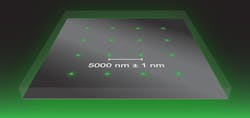From NIST: How to calibrate an optical microscope's field to atomic accuracy
Over the last two decades, scientists have discovered that the optical microscope can be used to detect, track, and image objects much smaller than their traditional limit, which is about half the wavelength of visible light.
Such pioneering research on superresolution microscopy, which won the 2014 Nobel Prize in Chemistry, has enabled researchers to track proteins in fertilized eggs, visualize how molecules form electrical connections between nerve cells in the brain, and study the nanoscale motion of miniature motors. Now, researchers at National Institute of Standards and Technology (NIST) have created a calibration tool that enables an optical microscope to measure these nanometer-scale details with a new level of accuracy, by calibrating the microscope's field to an accuracy of 1 nm.1
Measuring accuracy, not just precision
Because optical microscopes have not traditionally been used to study the nanometer scale, they typically lack the calibration—comparison to a standard to check that a result is correct—necessary to obtain information that is accurate at that scale. A microscope may be precise, consistently indicating the same position for a single molecule or nanoparticle. Yet, at the same time, it can be highly inaccurate—the location of the object identified by the microscope to within a billionth of a meter may, in fact, be millionths of a meter off due to unaccounted-for errors. “Precision without accuracy can be very misleading,” says Jon Geist, a NIST co-author of the study.
To address the problem, NIST developed a new calibration process that closely examines and corrects these imaging errors. The process uses stable reference materials that have the potential for mass production and widespread distribution to individual laboratories. The NIST team relied on nanometer-scale fabrication processes to develop the reference material. The researchers used electron beams and ion milling to form an array of pinhole apertures through a thin film of platinum on a glass slide. The process enabled the team to space the apertures 5000 nm apart to within an accuracy of about 1 nm. In this way, the researchers built a measure of accuracy into the aperture positions. Shining light through the array of apertures creates an array of points for imaging. Knowledge of the true spacing allows correction of field-dependent imaging errors and calibration of the microscope for measurements of position with high accuracy across a wide field of view. The aperture arrays, which would enable individual researchers to perform calibrations in their own laboratories, could improve by a factor of 10,000 the ability of optical microscopes to accurately locate the position of single molecules and nanoparticles.
Testing the arrays
Having calibrated their optical microscope using the arrays, the team reversed the process, using their microscope to identify imperfections in the prototype arrays from the nanofabrication process. "We tested the limits of nanofabrication to control the aperture spacing," notes Rob Ilic, manager of NIST's NanoFab. The ease and speed of optical microscopy could facilitate quality control of aperture arrays in a production process.
Finally, the team exploited the inherent stability of the aperture arrays to evaluate whether fluorescent nanoparticles, often used as fixed points of reference in optical microscopy, actually remained fixed to a particular point or if they moved around. The researchers found that while unintentional motions of their optical microscope made views of the nanoparticles blurry, using the aperture array showed that the nanoparticles were not actually moving at atomic scales.
REFERENCE:
1. Craig R. Copeland et al., Light: Science & Applications. Accepted article posted online 16 May 2018. doi: 10.1038/s41377-018-0031-z.
About the Author
John Wallace
Senior Technical Editor (1998-2022)
John Wallace was with Laser Focus World for nearly 25 years, retiring in late June 2022. He obtained a bachelor's degree in mechanical engineering and physics at Rutgers University and a master's in optical engineering at the University of Rochester. Before becoming an editor, John worked as an engineer at RCA, Exxon, Eastman Kodak, and GCA Corporation.

